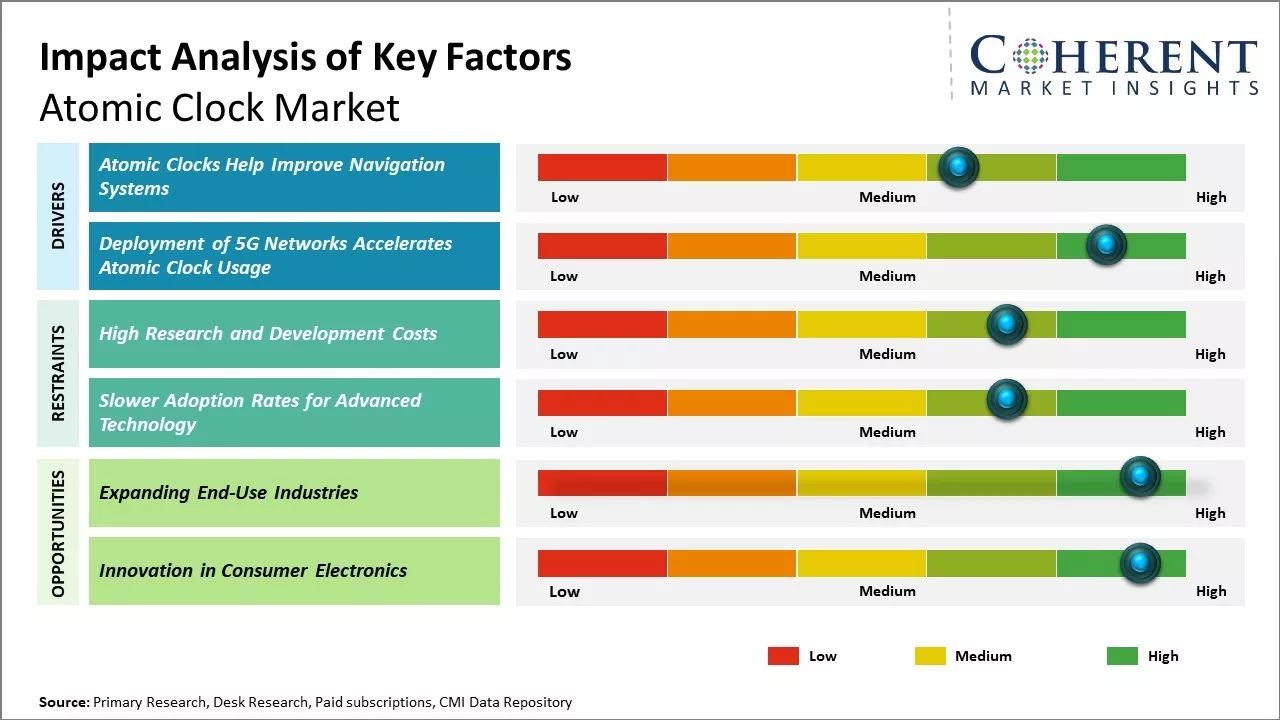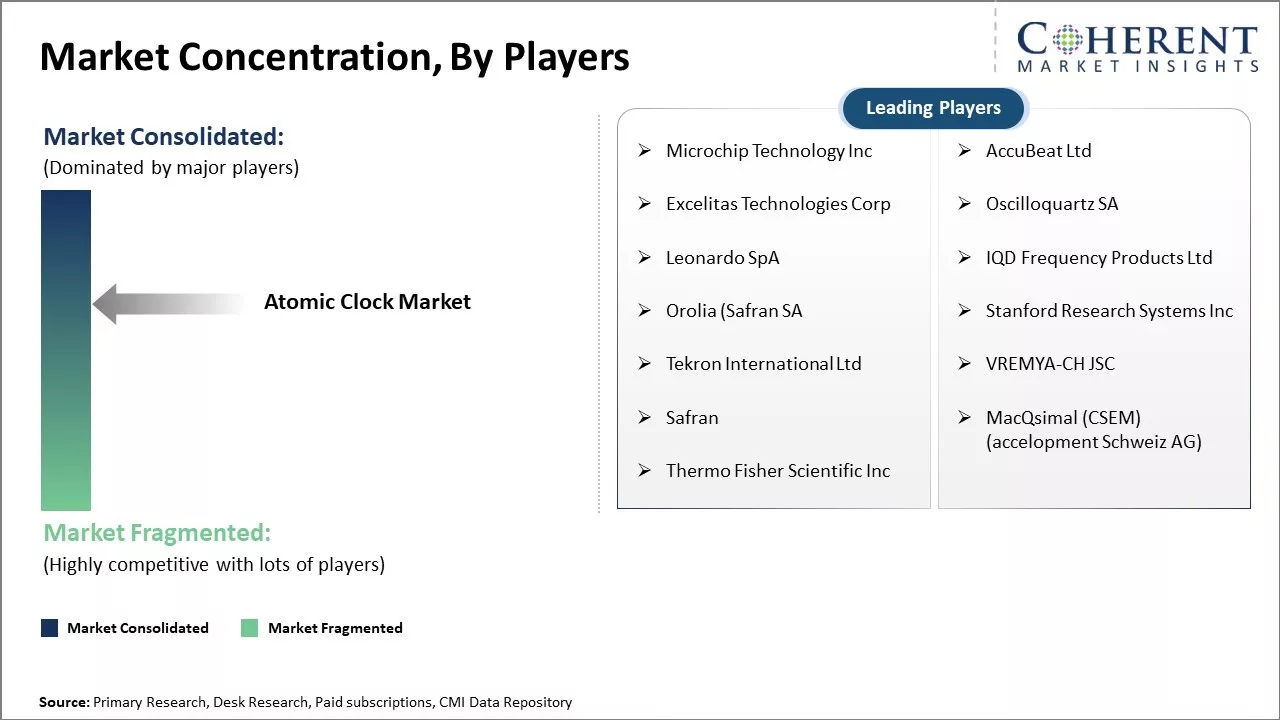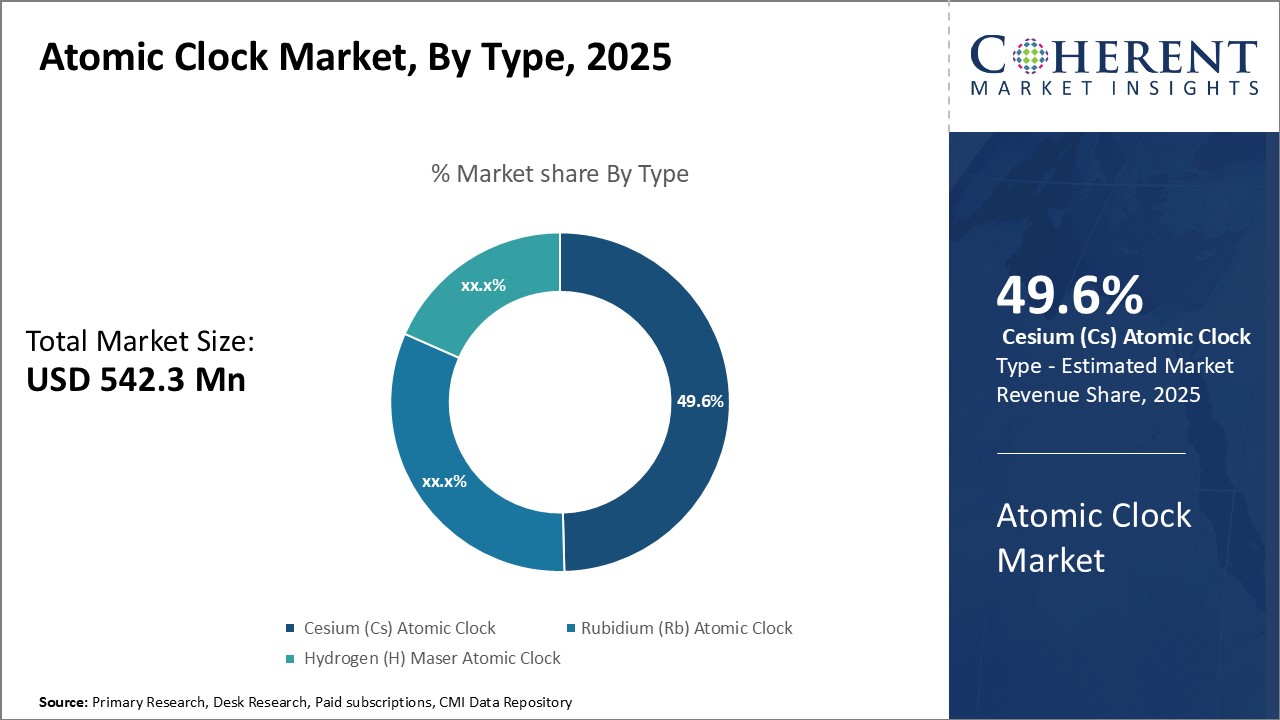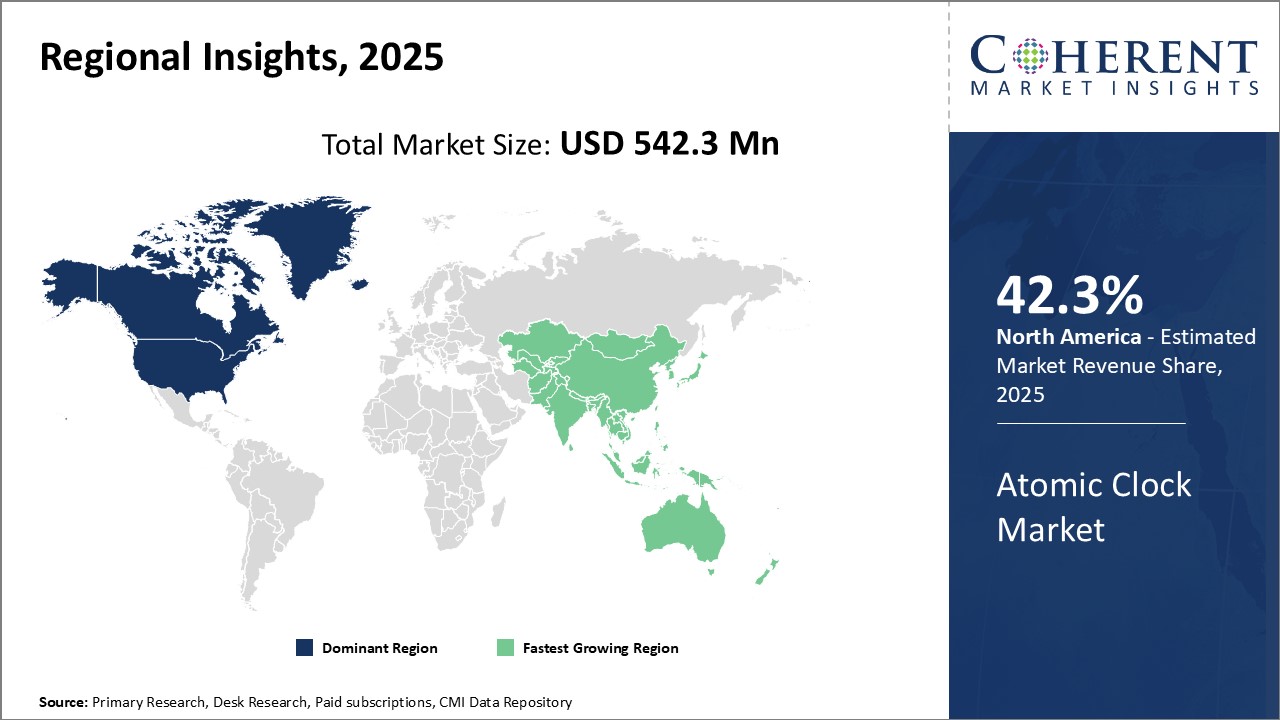Atomic Clock Market Size and Trends
The atomic clock market is estimated to be valued at USD 542.3 Million in 2025 and is expected to reach USD 843.2 Million by 2032, growing at a compound annual growth rate (CAGR) of 6.5% from 2025 to 2032.

Discover market dynamics shaping the industry: Download Free Sample
The atomic clock market is expected to witness a positive growth trend over the forecast period. Growing demand from various industries such as telecommunications, banking & finance, and scientific research & development is expected to drive the market growth. Atomic clocks play a crucial role in fields such as timing & frequency standards, navigation systems, Very Long Baseline Interferometry (VLBI), and Deep Space Network (DSN). In addition, the development of miniature atomic clocks and chip-scale atomic clocks for use in portable devices and Internet of Things (IoT) networks is anticipated to offer new revenue opportunities for players operating in the atomic clock market during the forecast timeframe.
Atomic Clocks Help Improve Navigation Systems
The demand for highly accurate navigation systems is increasing all over the world. From basic GPS in smartphones to advanced guided missile systems, navigation relies on precise timekeeping. Atomic clocks play a vital role in ensuring navigation systems can pinpoint locations within centimeters. Their extreme accuracy helps maps, offers traffic information, and enables other location-based services to function smoothly. As more critical infrastructure and transportation comes to depend on satellite navigation, so does the need grow for rock-solid timekeeping. Atomic clocks are unmatched in their ability to keep time with nanosecond precision across decades. This reliability factor is essential in applications like aircraft landings and autonomous vehicles.
For instance, in February 2022, physicists from the University of Wisconsin–Madison recently unveiled one of the most advanced atomic clocks to date. This innovative device, referred to as an optical lattice atomic clock, showcases remarkable precision, capable of discerning time differences to the extent of losing merely one second every 300 billion years. Notably, it represents the inaugural instance of a "multiplexed" optical clock, accommodating six distinct clocks within the same framework. This unique design empowers the research team to explore avenues for detecting gravitational waves, probing for dark matter, and uncovering novel insights into the realm of physics through the utilization of clocks.
Market Concentration and Competitive Landscape

Get actionable strategies to beat competition: Download Free Sample
Deployment of 5G Networks Accelerates Atomic Clock UsageThe rollout of 5G wireless networks presents new opportunities for atomic clocks but also poses fresh synchronization challenges. 5G promises gigabit speeds through technologies such as beamforming that rely on splitting cells into smaller zones. This results in far more base stations having to be installed and coordinated across wider coverage areas. Maintaining precise timing between all these nodes is critical for minimizing latency as well as ensuring a seamless user experience. The wider bandwidth and complex multiple access schemes in 5G also necessitate higher timing accuracy in order to avoid signal interference. Meeting 5G's synchronization needs looks unachievable without atomic clock inputs. Their ability to keep time with ultra-low drifting far surpasses traditional rubidium or cesium clocks. Major 5G chipset and infrastructure providers have thus been actively working atomic clocks into their solutions. More extensive timing backbone networks incorporating these high-end clocks are being constructed by carriers. The tight window for multi-millisecond synchrony in 5G becomes feasible solely through atomic technology. As telecom operators continue expanding their 5G footprints over the coming years, it will drive extensive deployment of atomic clocks both at centralized locations and distributed points of presence. Their matchless synchronization capabilities are pivotal for 5G networks to reach their throughput and latency targets.
Key Takeaways of Analyst:
The atomic clock market is expected to experience steady growth in the coming years driven by the increasing demand from telecommunication and tech industries. Many new 5G infrastructure projects will require precise timing solutions, presenting opportunities for atomic clock vendors. Healthcare is another emerging area where atomic clocks can enhance medical imaging technologies. Their accuracy and stability also allows for new IoT and networking applications.
However, high initial costs of atomic clocks remain a major restraint limiting their adoption compared to lower-cost alternatives. Ongoing R&D investments will be critical for vendors to reduce prices through economies of scale and novel miniature fabrication techniques. The telecom industry in North America and Asia Pacific is expanding vigorously which is likely to drive additional atomic clock integration for telecom networks. Several national defense modernization programs also involve atomic clocks.
The industrial and consumer segments are anticipated to be the fastest growing end uses through integration into various instruments, though from a smaller base. Meanwhile, academic research remains a solid backbone providing sustained demand. Overall the atomic clock market is maturing with steady incremental innovation versus disruptive leaps. Competitive pressures will strengthen among a handful of top players dominating production and related timing technologies.
In conclusion, the atomic clock market has clear long-term fundamentals despite challenges. Those able to lower costs or expand applications the most effectively will find the greatest opportunity.
Market Challenges: High Research and Development Costs
One of the key challenges faced by the atomic clock market is the high level of investment required for the research and development of new technologies. As the miniaturization and multiplication of atomic clocks progresses, R&D costs continue to rise. Additionally, the market has experienced slower adoption rates for newer and more advanced atomic clocks due to their higher price points compared to traditional clocks.
Market Opportunities: Expanding End-use Industries
There is a growing demand across various end-use industries such as aerospace, telecommunications, and scientific measurement. In particular, as 5G networks expand, the need for ultra-precise timing will accelerate. There is also opportunity for innovation in integrated atomic clock circuits suitable for consumer electronics and IoT devices.

Discover high revenue pocket segments and roadmap to it: Download Free Sample
Insights, By Type - Precision and Accuracy Drive the Cesium Atomic Clock AdoptionIn terms of type, cesium (Cs) atomic clock is expected to contribute the highest share of 49.6% in 2025, owing to its unparalleled precision and accuracy. Cesium atomic clocks are considered the most accurate time and frequency standards known, achieving long-term stability of a few parts in 1015. Due to its minuscule frequency drift over time, Cs atomic clocks are widely used in applications that require the highest level of timing precision such as international timekeeping and navigation systems. Their operation is based on the transition frequency of cesium-133 atoms which provides a very stable reference signal with minimal variation. Cs atomic clocks also offer long lifetime before needing repairs or recalibration compared to other atomic clock types. The demand from timing applications in sectors like telecommunications, satellite communications, and deep space exploration has resulted in the cesium standard becoming the primary frequency reference for civil time.
For instance, in August 2021, Microchip which is a manufactures microcontroller, mixed-signal, analog, and Flash-IP integrated circuits. introduced SA65 CSAC, designed for military and industrial systems, boasting ultra-high precision and low power consumption.
Insights, By End Users - Strategic Importance Drives Demand from Defense Agencies
In terms of end users, defense & space is expected to contribute the highest share of 83.62% in 2025, owing to the strategic importance of precise timing solutions. Atomic clocks play a crucial role in numerous defense technologies such as missile guidance systems, early warning radars, secure communications systems and signals intelligence. Their ultra-precise time and frequency synchronization capabilities are essential for intelligence gathering, command and control, weapons targeting and other military operations. Many countries prioritize technological superiority in atomic clock capabilities to gain strategic advantages. Consequently, defense agencies account for a sizable portion of research funding and procurement of the most advanced atomic clock technologies. The dependence of military systems on accurate timing also drives continuous upgrades to existing infrastructure with newer and more robust atomic clock solutions.
For instance, in June 2022, Orolia SA, a Positioning, Navigation and Timing solution provider, unveiled an upgraded version of its small-sized, weight, power, and cost (SWaP-C) miniaturized rubidium oscillator product line, MRO-50, to meet evolving military and aerospace requirements.
Insights, By Application - Dependable Navigation Spurs Atomic Clock Use in Navigation Applications
In terms of application, navigation is expected to contribute the highest share of 24.62% in 2025, due to the reliability provided by atomic clocks. Precise and continuous timing is indispensable for navigation systems used across industries. Modern navigation relies on signals from satellites which require atomic clocks on-board for synchronization. While traditional atomic clocks could experience interruptions, emerging rubidium atomic clock technology provides continuity in navigation even in GPS-denied or degraded environments. Their resilience and long-term accuracy supports mission-critical functions. Cesium atomic clocks further enhance reliability in civil aviation and maritime navigation. The need for backup and autonomous timing solutions is increasing autonomous driving, drones, and other robotics. Therefore, the demand for robust and dependable atomic clocks from navigation systems continues to rise in industries across the board.
Regional Insights

Need a Different Region or Segment? Download Free Sample
North America has established itself as the dominant region in the global atomic clock market. The region is expected to account for a market share of 42.3% in 2025. This can be attributed to the strong presence of leading atomic clock manufacturers such as Microsemi Corporation and Orolia Inc, who have their headquarters in the U.S. A major part of atomic clock research and development also takes place in the U.S., with organizations like the National Institute of Standards and Technology playing a crucial role. Moreover, the U.S. government has been a significant purchaser of atomic clocks for applications in defense, aerospace, and timing systems. This has ensured a steady demand from this region over the years. However, exports have grown substantially as well with American manufacturers supplying clocks worldwide.
The Asia Pacific market, especially China, has emerged as the fastest growing regional market for atomic clocks with a CAGR of 7.66% in 2025. Massive investments and initiatives by the Chinese government to develop high-tech indigenous capabilities have boosted the atomic clock industry in the country. Growing demand from telecommunications, electronics, and infrastructure development are major growth drivers. Manufacturers like Wuhan Huagong Gaoke have come up rapidly and now cater to domestic as well as international clients. The import of atomic clocks to China is also decreasing steadily as local production increases. On the other hand, exports are rising which reflects the improving competitiveness of Chinese atomic clock brands globally. Furthermore, some Chinese firms are actively scouting foreign acquisition opportunities to acquire critical technologies and increase their international footprint.
Market Report Scope
Atomic Clock Market Report Coverage
| Report Coverage | Details | ||
|---|---|---|---|
| Base Year: | 2024 | Market Size in 2025: | USD 542.3 Mn |
| Historical Data for: | 2020 To 2024 | Forecast Period: | 2025 To 2032 |
| Forecast Period 2025 to 2032 CAGR: | 6.5% | 2032 Value Projection: | USD 843.2 Mn |
| Geographies covered: |
|
||
| Segments covered: |
|
||
| Companies covered: |
Microchip Technology Inc, AccuBeat Ltd, Excelitas Technologies Corp, Oscilloquartz SA, Leonardo SpA, IQD Frequency Products Ltd, Orolia (Safran SA, Stanford Research Systems Inc, Tekron International Ltd, VREMYA-CH JSC, Safran, MacQsimal (CSEM) (accelopment Schweiz AG), and Thermo Fisher Scientific Inc |
||
| Growth Drivers: |
|
||
| Restraints & Challenges: |
|
||
Uncover macros and micros vetted on 75+ parameters: Get instant access to report
Atomic Clock Industry News
- On March 28, 2024, India, joining a group of four other nations, plans to synchronize its computer systems with a domestically developed 'Rubidium atomic clock.' This clock, launched within a 2G navigation satellite, was developed by the Indian Space Research Organisation (ISRO) for integration with the Indian Regional Navigation Satellite System (IRNSS), known as NavIC. NavIC was developed following the denial of GPS access to India by the American government during the Kargil War. Currently, Indian internet systems sync their time to the U.S.-based Network Time Protocol.
- On March 11, 2024, the European Space Agency (ESA), acting on behalf of the European Commission, awarded a contract worth USD 13.3 million to Leonardo S.p.A (Italy) and Istituto Nazionale di Ricerca Metrologica. The contract aims to design and develop a new ultra-precise atomic clock technology for the Galileo system.
- In June 2023, Microchip Technology Inc. a manufactures microcontroller, mixed-signal, analog, and Flash-IP integrated circuits. introduced the 5071B cesium atomic clock capable of autonomous timekeeping for extended periods in the event of GNSS denials
- In May 2023, India announced plans to launch its first second-generation navigation satellite using the Geosynchronous Satellite Launch Vehicle (GSLV) rocket, according to the Indian Space Research Organisation (ISRO)
- In October 2020, Microchip Technology Inc. acquired Tekron International Limited a network timing solutions provider, adding Tekron's expertise and widely adopted synchronization and timing products to its portfolio, crucial in today's increasingly digital and networked world
*Definition: The atomic clock market consists of companies that manufacture precision timekeeping devices known as atomic clocks. These highly accurate clocks use the resonance of atomic transitions to keep time, providing a standard for time and frequency that is more exact than quartz clocks. Products in this market range from smaller rubidium atomic clocks often used in aircraft or GPS networks to larger caesium atomic fountains installed in national metrology laboratories. With applications in navigation, communications, scientific measurement, and others.
Market Segmentation
- Type Insights (Revenue, USD Mn, 2020 - 2032)
- Rubidium (Rb) Atomic Clock
- Cesium (Cs) Atomic Clock
- Hydrogen (H) Maser Atomic Clock
- End Users Insights (Revenue, USD Mn, 2020 - 2032)
- Defense & Space
- Combat Aircraft and Helicopters
- Unmanned Vehicles
- Armoured Vehicles
- Portable Systems
- Naval Ships (Destroyers, Frigates, etc)
- Submarines
- Patrol Vessels
- Telecommunications
- Research Laboratories
- Defense & Space
- Application Insights (Revenue, USD Mn, 2020 - 2032)
- Surveillance
- Navigation
- Electronic Warfare
- Telemetry
- Communication
- Regional Insights (Revenue, USD Mn, 2020 - 2032)
- North America
- U.S.
- Canada
- Latin America
- Brazil
- Argentina
- Mexico
- Rest of Latin America
- Europe
- Germany
- U.K.
- Spain
- France
- Italy
- Russia
- Rest of Europe
- Asia Pacific
- China
- India
- Japan
- Australia
- South Korea
- ASEAN
- Rest of Asia Pacific
- Middle East & Africa
- South Africa
- GCC Countries
- Israel
- Rest of Middle East & Africa
- North America
- Key Players Insights
- Microchip Technology Inc
- AccuBeat Ltd
- Excelitas Technologies Corp
- Oscilloquartz SA
- Leonardo SpA
- IQD Frequency Products Ltd
- Orolia (Safran SA
- Stanford Research Systems Inc
- Tekron International Ltd
- VREMYA-CH JSC
- Safran
- MacQsimal (CSEM) (accelopment Schweiz AG)
- Thermo Fisher Scientific Inc
Share
Share
About Author
Suraj Bhanudas Jagtap is a seasoned Senior Management Consultant with over 7 years of experience. He has served Fortune 500 companies and startups, helping clients with cross broader expansion and market entry access strategies. He has played significant role in offering strategic viewpoints and actionable insights for various client’s projects including demand analysis, and competitive analysis, identifying right channel partner among others.
Missing comfort of reading report in your local language? Find your preferred language :
Transform your Strategy with Exclusive Trending Reports :
Frequently Asked Questions
EXISTING CLIENTELE
Joining thousands of companies around the world committed to making the Excellent Business Solutions.
View All Our Clients
